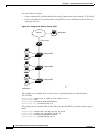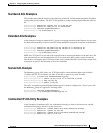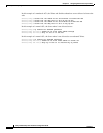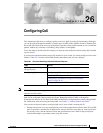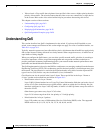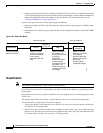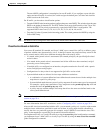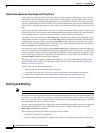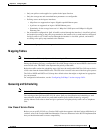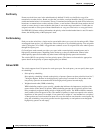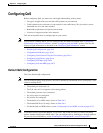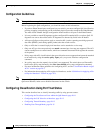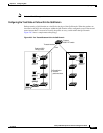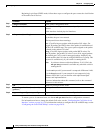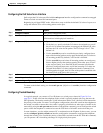
26-6
Catalyst 2950 Desktop Switch Software Configuration Guide
78-14982-01
Chapter 26 Configuring QoS
Understanding QoS
Classification Based on Class Maps and Policy Maps
A class map is a mechanism that you use to isolate and name a specific traffic flow (or class) from all
other traffic. The class map defines the criteria used to match against a specific traffic flow to further
classify it; the criteria can include matching the access group defined by the ACL. If you have more than
one type of traffic that you want to classify, you can create another class map and use a different name.
After a packet is matched against the class-map criteria, you further classify it through the use of a policy
map.
A policy map specifies which traffic class to act on. Actions can include setting a specific DSCP value
in the traffic class or specifying the traffic bandwidth limitations and the action to take when the traffic
is out of profile. Before a policy map can be effective, you must attach it to an interface.
You create a class map by using the class-map global configuration command or the class policy-map
configuration command. You should use the class-map global configuration command when the map is
shared among many ports. When you enter the class-map global configuration command, the switch
enters the class-map configuration mode. In this mode, you define the match criterion for the traffic by
using the match class-map configuration command.
You create and name a policy map by using the policy-map global configuration command. When you
enter this command, the switch enters the policy-map configuration mode. In this mode, you specify the
actions to take on a specific traffic class by using the class policy-map configuration or set policy-map
class configuration command. To make the policy map effective, you attach it to an interface by using
the service-policy interface configuration command.
The policy map can also contain commands that define the policer, the bandwidth limitations of the
traffic, and the action to take if the limits are exceeded. For more information, see the “Policing and
Marking” section on page 26-6.
A policy map also has these characteristics:
• A policy map can contain multiple class statements.
• A separate policy-map class can exist for each type of traffic received through an interface.
• A policy-map configuration state supersedes any actions due to an interface trust state.
For configuration information, see the “Configuring a QoS Policy” section on page 26-16.
Policing and Marking
Note This feature is available only if your switch is running the EI.
Policing involves creating a policer that specifies the bandwidth limits for the traffic. Packets that exceed
the limits are out of profile or nonconforming. Each policer specifies the action to take for packets that
are in or out of profile. These actions, carried out by the marker, include dropping the packet or marking
down the packet with a new user-defined value.
You can create an individual policer. QoS applies the bandwidth limits specified in the policer separately
to each matched traffic class. You configure this type of policer within a policy map by using the
policy-map configuration command.
When configuring policing and policers, keep these items in mind:
• By default, no policers are configured.
• Policers can only be configured on a physical port. There is no support for policing at a VLAN level.



